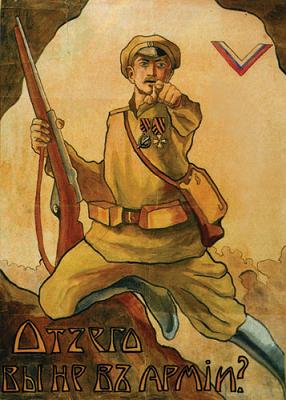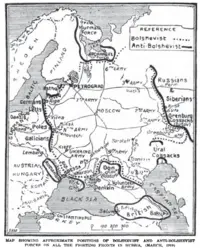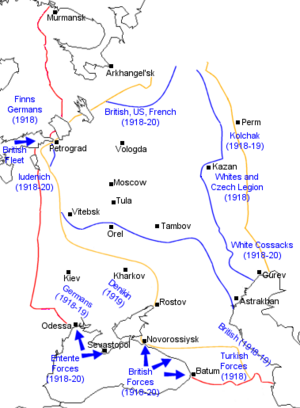The Volunteer Army
The Volunteer Army (Добровольческая армия in Russian, or Dobrovolcheskaya armiya) was a counterrevolutionary army in South Russia during the Russian Civil War of 1918-1923. Part of the wide White Russian resistance movement, the Volunteer Army itself was a spent force by early 1920, although resistance continued, mainly in the East, until June, 1923. The White movement received some support from the West European powers, who sympathized with their cause but this was inadequate and insufficient to defeat the Soviets. The Western powers were busy with the follow-up to the end of World War I, including extending their empires by carving up former German and Ottoman Empire possession among themselves. No one, too, foresaw all the implications of a communist Russia. One reason fro this was that Russia was not yet an industrial power, and did not appear to represent much of a threat. By World War II, the situation was very different and in the post-World War II world, the Soviet were a super-power in their own right, one that at times rivaled the United States for world supremacy. The Soviets were better organized and had the support, at this stage, of the general population who assumed that they would benefit from the communist system. In contrast, many aristocrats, associated with a failed, authoritarian regime, fought in the various White militia. Had the resistance movement succeeded, world history would have taken a different course. The Second World War may still have occurred but East Europe would probably not have fallen to communism, and the Cold War would not have happened.
Origin
The Volunteer Army began forming in November-December of 1917 by General Mikhail Alekseev in Novocherkassk and General Lavr Kornilov and his supporters. Konilov had been a senior officer in the Russian army. A Cossack, he became Supreme Commander-in-Chief in June, 1917 until the Soviets pulled out of the war March 3, 1919. The Volunteer Army was part of the wider so-called White Russian resistance movement against the communists. Initially, the Volunteer Army included volunteering officers, cadets, students and Cossacks. On December 27, 1917 (January 9, 1918), the creation of the Volunteer Army was officially announced. Alekseev became its overall leader, Kornilov—its Commander-in-chief, General Alexander Lukomsky - its Chief of Staff, General Anton Denikin—commander of the 1st Division and General Sergey Markov – commander of 1st Officers regiment. They also created the so called Special Council at the headquarters, which included also included prominent civilian politicians such as Peter Struve, Pavel Milyukov, Mikhail Rodzianko, Sergey Sazonov and Boris Savinkov.
In early January 1918, the Volunteer Army numbered approximately 4,000 men and fought against the Red Army together with the units of General Aleksei Kaledin. In late February, the Volunteer Army had to retreat from Rostov-on-Don due to the onset of the Red Army and left for Kuban in order to unite with the Kuban Cossack formations, a manoeuvre known as the Ice March. However, most of the Kuban Cossacks did not give their support to the Volunteer Army. Only a small unit (3,000 men) under the command of General Viktor Pokrovsky joined the Volunteer Army on March 26, 1918, increasing its number to 6,000 people. The Volunteer Army's attempt to capture Yekaterinodar between April 9 and April 13 was a fiasco, costing Kornilov his life. General Denikin took the command over the remnants of the Volunteer Army and left for the remote stanitsas beyond the Don region. In June 1918, 3,000 men of Colonel Mikhail Drozdovsky joined the Volunteer Army. On June 23, the Volunteer Army (8,000-9,000 men) began its so called Second Kuban Campaign with the support from Pyotr Krasnov. By September 1918, the Volunteer Army had already had 30,000-35,000 men thanks to mobilization of the Kuban Cossacks and "counterrevolutionary elements," gathered in the North Caucasus. Thus, the Volunteer Army took the name of the Caucasus Volunteer Army.
In the Autumn of 1918, the governments of Great Britain, France and the USA increased their material and technical assistance to the Volunteer Army. With the support from Entente, the forces of the South Russian Whites were combined into the so called Armed Forces of South Russia (Вооружённые силы Юга России, or Vooruzhenniye sily Yuga Rossii) under the command of Denikin. In the late 1918 – early 1919, Denikin managed to inflict a defeat on the 11th Soviet Army and capture the North Caucasus region. In January of 1919, the Caucasus Volunteer Army was divided into the Caucasus Army and the Volunteer Army, which would later be joined by the Don Army, created from the remnants of Krasnov's Cossack army. After capturing Donbass, Tsaritsyn and Kharkov in June 1919, Denikin began to advance towards Moscow on June 20 (July 3). According to his plan, the main blow to Moscow was to be inflicted by the Volunteer Army (40,000 men) under the command of General Vladimir May-Mayevsky.
The Wider White Resistance
The term "White Russian" refers to the opposition to the Bolshevik-communist revolutionaries, whose symbolic color was red. There was no single, dominant ideology. Among White Army leaders, neither General Kornilov of the Volunteer Army nor General Denikin also of the Volunteer Army were monarchists. On the other hand, General Wrangel—also Volunteer Army—did have monarchist sympathies, but, as he made it clear, was willing to serve under a non-Bolshevik democratically elected Russian government. In any event, although many of its officers held monarchist ideas, it is inaccurate to state, as it is done sometimes, that the White Army was a monarchist army. It can be said, however, that the White Army as a whole generally believed in a united multinational Russia (being opposed to separatists who wanted to create nation-states in the place of the old Russian Empire).
The White Army also drew support from other political movements, including democrats, social revolutionaries, and others who opposed the October Revolution; at other times and in other places, the same groups supported the Red Army instead.
The rank-and-file troops of the White Army included both active opponents of the Bolsheviks (many Cossacks, for example), and spanned a variety of volunteers and conscripts, from nobles to peasants.
Some leaders of the White movement, particularly General Wrangel, formulated political concepts based on Russian traditionalism that were taken up and developed in emigre circles after the end of the Civil War by Russian thinkers such as Ivan Ilyin; who had many philosophical similarities with the Slavophiles. This became known as the "White Idea." It has been argued if the "White Idea" was in fact developed after the war, or simply was formulated after the war in a more doctrinal format. Not all White Army veterans were sympathetic to it, although virtually all organized veterans were (i.e. the Russian All-Military Union).
Monarchist tendencies reached a peak amidst the veterans of the White movement, while republicanism became rarer. The liberal policies of Alexander Kerensky and his socialist-democratic oriented provisional government were seen as largely responsible for preparing the country for the October Revolution. In August of 1922, two months before its defeat, the far eastern White Army of General Mikhail Diterikhs went as far as to convene the Zemskiy Sobor of Preamursk, and elect (without his participation) Grand Duke Nikolai Nikoaievich Romanov as tsar of all Russia.
There were also independent groups such as the Green Army as well as the Black Army of Nestor Makhno, who declared themselves against both the Reds and Whites, although occasionally they sought alliances with one side or the other.
Western Support
At times the Western Allies, the Central Powers, and other foreign forces provided assistance to several White Army units, and there were some volunteer units on the ground. However, the Western powers were recovering from the cost and devastation of World War I, and were not in a position to offer much support even if their sympathies were on the side of the White Russians. This caused the Soviets to accuse the White Army of representing the interests of foreign powers.
The White Army was also accused by the Soviets of cruelty in its conquered territories, usually against the workers, for which the Soviet historiography would dub this regime "Denikinschina." Some of the units and formations of the Volunteer Army possessed good military skills and fighting strength due to a large number of officers in its ranks, who hated and despised the Soviets. However, the Volunteer Army's fighting efficiency started to decrease in the summer of 1919 in light of significant losses and conscription of mobilized peasants and even Red Army soldiers in captivity.
During the counter-offensive of the Red Army (since October 1919), the Volunteer Army sustained a decisive defeat and rolled back to the South. In the early 1920, it retreated to the areas beyond the Don region and was reduced to a Corps of 5,000 men under the command of General Alexander Kutepov.
On March 26 and March 27, 1920, the remnants of the Volunteer Army were evacuated from Novorossiysk to the Crimea, where they merged with the army of Pyotr Wrangel.
Theaters of Operation
The Russian Civil War between Whites and Reds raged from November of 1917 until 1921, with isolated pockets of resistance continuing in the Far East until 1923. The White Army, with the occasional aid of Allied (and sometimes, Central powers) forces from outside Russia (Japanese, British, Canadian, French, American, German, Australian (including two who received the Victoria Cross for their actions against the Red Army), Greek, Czechoslovak) held sway in some areas (especially Siberia, Ukraine and the Crimea) for periods of time and put considerable bodies of troops into the field. But they failed to unite or to co-operate effectively amongst themselves, and the Bolshevik Red Army eventually gained the upper hand.
The major theaters of the White armies can be grouped as follows:
- The Southern front: Started on November 15, 1917 by General Mikhail Alekseev and commanded by General Lavr Kornilov, later headed by General Denikin and named the "Armed Forces of the South of Russia." This front had the most massive scale operations and overall posed the most serious threat to the Bolsheviks. In the beginning, it based itself entirely on volunteer support, a significant amount of it coming from the cossacks who were amidst the first to protest against Bolshevik rule. In 1919, after the Denikin offense on Moscow collapsed, the army was forced into a massive retreat. General Wrangel reorganized the army in Crimea, formed a provisional government (recognized by France), and began a new advance. It quickly failed when Polish leader Józef Piłsudski made a separate peace with the Soviets and withdrew Poland from the war.
- The Eastern (Siberian) front: Started in the spring of 1918 as an underground movement amidst army officers and right leaning socialist forces. The front began a major offensive in collaboration with the Czechoslovak Legions who were stuck in Siberia (local Bolshevik governments barred them from leaving Soviet Russia). Admiral Kolchak headed the resistance and a provisional Russian government. Britain encouraged him to side with the White cause when he offered to enlist in the British Army. They thought he was more valubale trying to defeat the Soviets. He also joined the Volunteer Army. The army made significant advances in 1919, but was pushed back to the far east where it continued to resist up to October of 1922. When Vladivostock fell October 25, 1922 the Civil War effectivelt ended, although a small pocket of White resistance in the Pacific coast Ayano-Maysky District held out until June 17, 1923.
- The Northern and North-Western fronts: Started immediately after the Bolshevik takeover by Pyotr Krasnov, then headed by General Yudenich, General Miller, Prince Liven, and others. These fronts had less coordination than the Southern Army of Denikin, including a few problematic adventurers such as General Bermont Avalov and General Bulakh Bulakhovich (the former declared war on neighboring Estonia). The most notable achievement was the attack on Petrograd, then the capital of Soviet Russia.
Soviet Victory
By 1924, the Soviets controlled the whole of mother Russia. A few White Russians continued to campaign for resistance in exile but and the communkist regime would last until its collapse in 1991. Had the Volunteer Army and the White Russians won, world history would have been very different.
ReferencesISBN links support NWE through referral fees
- Bischoff, Josef. 1935. Die letzte Front; Geschichte der Eisernen Division im Baltikum. 1919. Berlin: Buch und Tiefdruck Gesselschaft.
- Dupuy, R. Ernest, and Trevor Nevitt Dupuy. 1993. The Harper encyclopedia of military history from 3500 B.C.E. to the present. New York, NY: HarperCollins. ISBN 9780062700568
- Goltz, Rüdiger, and Ebba von Bonsdorff. 1920. Krigsminnen från Finland och Baltikum. Helsingfors: Söderström & c:o.
- Thompson, John M., and William Ewing Gleason. 1996. A vision unfulfilled Russia and the Soviet Union in the twentieth century. Lexington, MA: D.C. Heath. ISBN 9780669282917
Credits
New World Encyclopedia writers and editors rewrote and completed the Wikipedia article in accordance with New World Encyclopedia standards. This article abides by terms of the Creative Commons CC-by-sa 3.0 License (CC-by-sa), which may be used and disseminated with proper attribution. Credit is due under the terms of this license that can reference both the New World Encyclopedia contributors and the selfless volunteer contributors of the Wikimedia Foundation. To cite this article click here for a list of acceptable citing formats.The history of earlier contributions by wikipedians is accessible to researchers here:
The history of this article since it was imported to New World Encyclopedia:
Note: Some restrictions may apply to use of individual images which are separately licensed.


